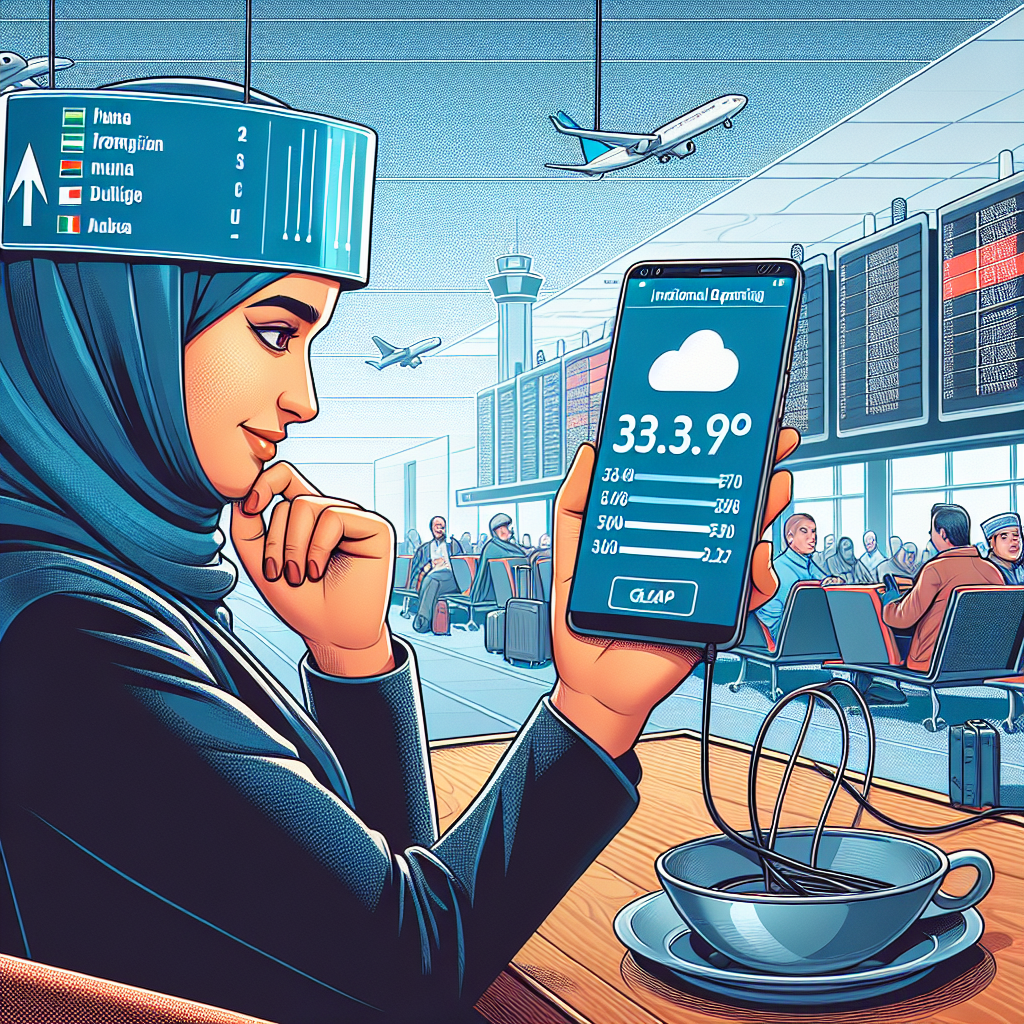In a world where staying connected is more important than ever, managing your data usage while traveling is essential to avoid unexpected charges and stay within your data cap. Navigating unfamiliar locations and relying on mobile data can quickly eat away at your allowance, leaving you scrambling to find Wi-Fi hotspots or pay costly overage fees. However, with a few savvy strategies, you can ensure you stay within your data cap without sacrificing your online needs. From downloading offline maps to turning off automatic video streaming, there are plenty of ways to stay connected while keeping your data usage in check. Explore these smart and practical tips for staying within your data cap while traveling.
Understanding Data Caps
-
Data caps refer to the specific limit imposed by internet providers on the amount of data that can be used within a certain period, usually monthly.
-
Internet providers implement data caps to manage network congestion, ensure fair usage among customers, and potentially drive revenue through overage charges.
-
Travelers may face challenges with data caps while on the go, especially if they rely heavily on mobile data for navigation, communication, and entertainment.
Pre-Trip Preparations

Researching Data Plans
When preparing for a trip and aiming to stay within your data cap, researching data plans thoroughly is crucial to avoid unexpected charges and overages. Here are some key aspects to consider when delving into the realm of data plans:
-
Comparing data plans from different providers: Before embarking on your journey, take the time to compare data plans offered by various providers. Look into factors such as data limits, roaming options, and international coverage. By exploring different options, you can select a plan that aligns with your data usage needs while traveling.
-
Understanding the terms and conditions of data plans: Dive deep into the fine print of data plans to grasp the intricacies of their terms and conditions. Pay attention to details such as data throttling after reaching the cap, additional charges for exceeding limits, and any restrictions on certain types of data usage. Being well-informed about these aspects can help you make informed decisions and prevent bill shocks later on.
-
Identifying roaming charges and limitations: For travelers venturing beyond their home country, understanding roaming charges and limitations is paramount. Some data plans may offer limited or costly roaming options, which can quickly deplete your data cap. Look for plans that provide affordable and transparent roaming services or consider purchasing local SIM cards at your destination to avoid excessive charges.
Utilizing Wi-Fi Networks
Pre-Trip Preparations
-
Locating Wi-Fi Hotspots in Travel Destinations: Prior to embarking on your journey, research the availability of Wi-Fi hotspots in the areas you will be visiting. Look for local cafes, libraries, or hotels that offer free Wi-Fi to save on data usage. Additionally, consider purchasing a portable Wi-Fi device or SIM card for your destination to access local networks without exceeding your data cap.
-
Ensuring the Security of Public Wi-Fi Networks: When connecting to public Wi-Fi networks, exercise caution to protect your personal information from potential security threats. Avoid accessing sensitive data such as online banking or personal accounts while connected to public Wi-Fi. Verify the network’s legitimacy with staff if in doubt and refrain from sharing confidential information over unsecured connections.
-
Using Virtual Private Networks (VPNs) for Added Protection: Employing a VPN while traveling can safeguard your data by encrypting your internet traffic and providing anonymity online. Choose a reputable VPN service to establish a secure connection, especially when using public Wi-Fi networks. VPNs can prevent unauthorized access to your information and mitigate the risks associated with unsecured connections, helping you stay within your data cap while traveling.

Data Management Tips on the Go
Monitoring Data Usage
ment Tips on the Go
Smart travelers understand the importance of monitoring their data usage while on the move. Whether for business or leisure, staying within the confines of a data cap can be challenging but not impossible with the right strategies in place. Here are some effective methods for keeping a close eye on data consumption:
-
Using Built-In Data Tracking Tools on Smartphones: Most smartphones offer built-in features that allow users to monitor their data usage. By navigating to the settings menu and selecting the data usage option, travelers can view detailed breakdowns of their data consumption, including which apps are using the most data. This information can help users make informed decisions about which apps to restrict or use sparingly to avoid exceeding their data cap.
-
Installing Third-Party Apps for Detailed Data Monitoring: For those seeking more comprehensive data tracking capabilities, third-party apps dedicated to monitoring data usage can be valuable tools. These apps often provide real-time updates on data consumption, offer customizable alerts when approaching data limits, and may even suggest ways to optimize data usage. By leveraging these apps, travelers can gain a deeper understanding of their data habits and take proactive measures to stay within their allocated limits.
-
Setting Data Usage Alerts to Avoid Exceeding Limits: One of the most effective ways to prevent data overages while traveling is to set up data usage alerts on your device. By establishing a threshold for data consumption and configuring alerts to notify you when nearing that limit, you can proactively manage your usage and adjust your behavior accordingly. These alerts serve as valuable reminders to curb data-heavy activities or connect to Wi-Fi networks whenever possible to conserve data for essential tasks.
By employing a combination of these monitoring strategies, travelers can stay vigilant about their data usage and avoid costly overages while on the go. With the right tools and habits in place, staying within data caps becomes a manageable task, ensuring a seamless and stress-free travel experience.
Optimizing Apps and Settings
Data Management Tips on the Go
When traveling and trying to stay within your data cap, optimizing apps and settings can make a significant difference in conserving your data usage. Here are some practical tips to help you manage your data more efficiently:
-
Disabling automatic app updates: One way to prevent unnecessary data usage is by turning off automatic updates for your apps. This way, you can choose when to update them, preferably when connected to a Wi-Fi network. To do this, go to your app store settings and disable the automatic update feature.
-
Limiting video streaming quality: Video streaming consumes a considerable amount of data, so adjusting the quality settings can help you stay within your data cap. Many streaming services offer the option to lower the video quality, which can significantly reduce data usage without compromising your viewing experience. Check the settings within the streaming apps to adjust the video quality to a lower resolution.
-
Enabling data-saving modes on apps: Some apps have built-in data-saving modes that can help reduce their data usage while still allowing you to use them on the go. These modes typically optimize the app’s performance by lowering the quality of images and videos or by reducing background data usage. Look for data-saving options in the settings of your most-used apps and enable them to minimize their impact on your data allowance.
Offline Access Strategies
When traveling and trying to stay within data cap limits, utilizing offline access strategies can be a game-changer. By planning ahead and downloading essential content for offline use, you can save significant amounts of data. Here are some effective offline access strategies to consider:
-
Downloading Maps and Content for Offline Use: Before embarking on your journey, make sure to download maps of your destination area using apps like Google Maps or Maps.me. This way, you can navigate without needing to constantly use data for real-time mapping. Additionally, consider downloading important documents, such as travel itineraries or reservation confirmations, to access them without data connectivity.
-
Saving Articles and Videos for Offline Viewing: To entertain yourself during flights or long commutes without draining your data, save articles, e-books, podcasts, or videos for offline viewing. Apps like Pocket or Kindle allow you to download content for later consumption, ensuring you stay entertained without exceeding your data cap.

– Utilizing Offline Navigation Apps: In addition to traditional mapping apps, consider using offline navigation apps like HERE WeGo or Sygic GPS Navigation. These apps offer offline maps and turn-by-turn navigation, eliminating the need for continuous data usage while driving or walking in unfamiliar locations. By relying on offline navigation solutions, you can save data for essential communication and browsing needs during your travels.
Communication Strategies
Utilizing Messaging Apps
When traveling and trying to stay within data caps, one effective communication strategy is to leverage messaging apps that allow for communication over Wi-Fi. These apps, such as WhatsApp, enable users to send text messages, make voice calls, and even have video calls without consuming their mobile data. By connecting to a Wi-Fi network, travelers can use these apps to stay in touch with friends and family without worrying about exceeding their data limits.
Sending messages over Wi-Fi using apps like WhatsApp
Messaging apps like WhatsApp provide a convenient way to send text messages without using cellular data. By connecting to a Wi-Fi network, travelers can send messages to individuals or groups, share links, and even send voice messages through these platforms. This not only helps in staying within data caps but also ensures instant communication while on the go.
Making voice and video calls via Wi-Fi
Another advantage of utilizing messaging apps is the ability to make voice and video calls over Wi-Fi. Instead of using traditional phone services that consume data, travelers can opt for apps like WhatsApp to have high-quality calls without impacting their data limits. This feature is particularly useful for international calls, where using Wi-Fi can significantly reduce communication costs.
Sharing photos and videos without consuming data
Messaging apps also offer the functionality to share photos and videos without eating into the data cap. By uploading media files over a Wi-Fi connection, travelers can share their experiences in real-time without worrying about exceeding their data limits. This feature is beneficial for sharing travel moments with loved ones without the constraints of data usage.
Email and Cloud Storage Management
-
Syncing emails in batches
When traveling and trying to stay within data caps, one effective strategy is to sync emails in batches. Instead of allowing your email client to constantly sync and update in real-time, adjust the settings to sync emails at specific intervals, such as every hour or manually. By syncing emails in batches, you can reduce the amount of data consumed by your email app, allowing you to stay within your data cap limits while still staying connected. -
Uploading files to cloud storage before traveling
Another essential tactic for managing data usage while traveling is to upload important files to cloud storage before embarking on your trip. By proactively uploading documents, photos, and other essential files to services like Google Drive, Dropbox, or iCloud, you can access them without relying on your mobile data connection. This approach not only helps you stay within your data cap but also ensures that your critical files are easily accessible regardless of your internet connectivity while on the go. -
Setting up offline access to important documents
To further optimize your data usage while traveling, consider setting up offline access to essential documents stored in your cloud storage accounts. Many cloud storage services offer the option to download files locally to your device, allowing you to access them without an internet connection. By pre-downloading important documents for offline access, you can minimize your reliance on mobile data for accessing critical information, thereby staying within your data cap limits effectively.
Emergency Data Saving Tips
Data Rollover Options
When it comes to managing your data cap while traveling, understanding the data rollover options provided by your carrier can be a game-changer. Here are some key strategies to help you make the most of data rollover:
-
Understanding data rollover policies of providers: Before you embark on your journey, take the time to familiarize yourself with the data rollover policies of your service provider. Some carriers allow unused data to roll over to the next billing cycle, offering you a buffer in case you exceed your data cap while traveling.
-
Utilizing accumulated data from previous months: If your plan includes the ability to accumulate unused data from previous months, consider leveraging this feature to stay within your data cap while on the go. By tapping into the data reserves you’ve built up over time, you can avoid unexpected overage charges during your travels.
-
Checking for any expiration dates on rollover data: While data rollover can be a valuable tool for staying within your data cap, it’s essential to be mindful of any expiration dates associated with the accumulated data. Make sure to keep track of when your rollover data expires to ensure that you use it before it’s no longer available.
Data Passes and Temporary Add-Ons
When traveling and facing the risk of exceeding your data cap, utilizing data passes and temporary add-ons can be a lifesaver. These options allow you to supplement your existing data plan with additional data for a specified period, ensuring you stay connected without incurring excessive charges. Here’s a closer look at how you can effectively manage your data usage through these strategies:
-
Exploring temporary data packages for travel: Before embarking on your journey, research the temporary data packages offered by your service provider for the specific destination you will be traveling to. These packages are often designed to provide a predetermined amount of data for a set price, allowing you to control your expenses while enjoying connectivity during your trip.
-
Purchasing data passes for specific usage needs: If you anticipate requiring more data than usual for activities such as streaming content or navigating unfamiliar locations, consider purchasing data passes that offer a significant amount of data for a fixed fee. This can be a cost-effective way to meet your increased data needs without committing to a long-term plan.
-
Ensuring the validity period and coverage of add-on data: Before opting for a data pass or temporary add-on, carefully review the validity period during which the additional data will be available for use. Additionally, verify that the coverage of the add-on data extends to the areas you will be visiting to avoid unexpected data roaming charges. By understanding the terms and conditions associated with these options, you can make informed decisions to stay within your data cap while traveling.
FAQs: Strategies for Staying Within Data Cap While Traveling
How can I minimize data usage while traveling?
To minimize data usage while traveling, you can make use of Wi-Fi whenever possible. Before leaving for your trip, download maps, music, and videos for offline use. Additionally, you can disable automatic app updates and limit streaming services to conserve data.
Are there specific apps that can help me stay within my data cap while traveling?
Yes, there are several apps available that can help you monitor and reduce data usage while traveling. Apps like My Data Manager, Data Usage Monitor, and Datally can track your data usage in real-time and provide alerts when you are reaching your limit. These apps also offer features to restrict background data, track Wi-Fi usage, and optimize data consumption.
What should I do if I exceed my data cap while traveling?
If you exceed your data cap while traveling, you can contact your mobile carrier to inquire about purchasing additional data or increasing your data plan temporarily. Alternatively, you can look for Wi-Fi hotspots in your area to avoid using mobile data until your plan resets.
Are there any other tips for staying within my data cap while traveling?
In addition to connecting to Wi-Fi whenever possible and monitoring your data usage, you can also consider using data-saving modes on your smartphone. These modes can restrict background data usage, limit app updates, and optimize data consumption. Furthermore, you can avoid high-data activities such as video streaming and online gaming while on-the-go.


